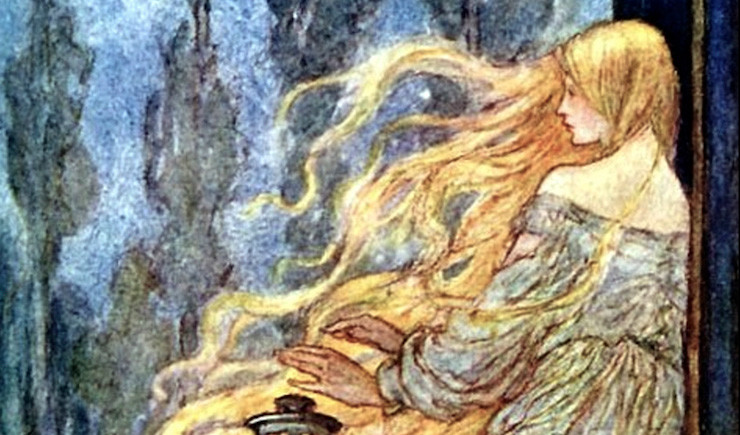Rapunzel is a fascinating story, full of bizarre little oddities that invite writers and storytellers to reinvent, tweak, and question all aspects and motivations. Such a strange set of circumstances: a mother’s longing, a witch’s garden, that odd name… (Might as well have called her Iceberg or Kale, though Rapunzel is better known as a girl in a tower than a leafy green at this point.)
If you aren’t familiar with the tale (or are only familiar with the popular animated version by a certain giant media company), please allow me to summarize…
A pregnant woman looks into a witch’s garden and becomes obsessed with eating some rapunzel (basically a salad green). She tells her husband she will die if she doesn’t get to eat it. He sneaks into the garden and gets her some, either once or twice, and is caught by the witch. The witch agrees to let him live, and take the greens, as long as the expectant parents turn over their child to her. They agree (with varying degrees of misery), and when the baby is born the witch comes to claim the child and names her Rapunzel. She takes the baby girl to a tower deep in the woods where she raises her—in some versions with affection and in some versions treating her as more of a possession or a prize. (It’s not exactly clear why the witch wanted the baby, in most early tellings of the tale.)
Rapunzel grows up in the tower, which has no door or only a locked door, depending on who you ask. The witch visits her, bidding her to throw down her long hair out of the tower’s window, which she then climbs. One day a prince hears Rapunzel singing, witnesses the interaction with the witch, and then when the witch leaves, tries it himself. He and Rapunzel fall in love and (chastely or not, depending on who you ask) develop a relationship. The witch either catches them at it, or catches on when Rapunzel asks why her gowns don’t fit at the stomach anymore. The witch cuts Rapunzel’s hair and banishes her to the desert, then waits for the prince to return. When he does, she lures him in with the now-detached locks, has a few choice words to say to him, and throws him out of the tower. He usually falls into some thorn bushes which pierce his eyes and blind him—yes, this is the good, old fashioned kind of fairy tale lore, this is what we come back for. He wanders blindly until he again hears Rapunzel singing and finds her in the desert, where she’s given birth to twins. Her tears of grief and/or joy fall into his wounded eyes and he’s cured. He takes her home to his kingdom aaaand they…yup, you guessed it, live happily ever after.
I’ve always liked this story, as strange as it is, because it’s the type of fairy tale with plenty of space in the narrative for characters to grow and get to know each other, and for us to wonder about their motivations and feelings. The mother, or the parents, make a decision to steal food, not to keep from starving but to satisfying an extreme craving. The witch, who wants a child, for some purpose or other. Rapunzel herself, growing up in isolation. The prince, who falls in love with a beautiful voice even before seeing a beautiful face. The two lovers, who manage to find each other against all odds and create their own little family. All of this room and time to delve into motivations and feelings and hopes and fears means that Rapunzel retellings can be wildly varied and yet easily recognizable by their most basic components: Greens, tower, hair. Cravings, isolation, rescue. Maiden, witch, prince, babies…
All these versions nod to these familiar and iconic elements but use them in vastly different ways, and I do believe that tells us as much about storytelling as it tells us about this one story, capable of striking so many different chords depending on its different tellers.
“Let Down Your Hair” by Juliet Marillier (Prickle Moon)
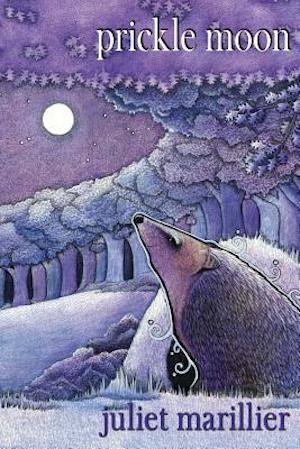
Marillier’s gorgeous, brief retelling borrows much of Rapunzel’s story to tell a tale about stories and stewardship. The narrator of this version renames herself daily, as well as telling new stories every day, guardian as she is over a pot of simmering soup which is much more than a meal. When her witch leaves her one day, she sustains herself on stories, and when her prince (a humble woodcutter, in this case) appears, it takes them some time to figure out how to reach each other. As much a story about finding someone who will meet you where you are as it is a retelling of the classic tale, this one is sweetly satisfying, especially for those of us who like to tell stories daily.
“Open Your Window, Golden Hair” by Tanith Lee
(Fearie Tales: Stories of the Grimm and Gruesome, edited by Stephen Jones)
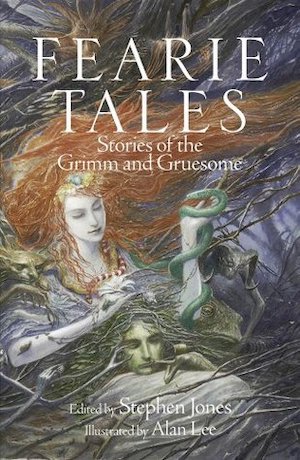
This is certainly the grimmest Rapunzel retelling I’ve ever come across, with a horrifyingly logical twist. Young Brown is on a walking tour through the country when he spies an alluring tower in the distance, but he travels on to his scheduled stop for the night, where the innkeeper tells him that even to look upon the tower is considered bad luck, and he certainly shouldn’t return there. But the next morning Brown finds himself turned around, heading back the way he came, and there’s the tower again. As he mentally composes his thoughts on the architecture, the anecdote he’ll tell his friends later, he realizes he’s wandered all the way up, and why not, might as well take a look. What he finds, well, I won’t give it away, but I’ll never read about Rapunzel’s hair again without thinking of this version.
“Rapunzel” by Anne Bishop
(Black Swan, White Raven, edited by Ellen Datlow and Terri Windling)
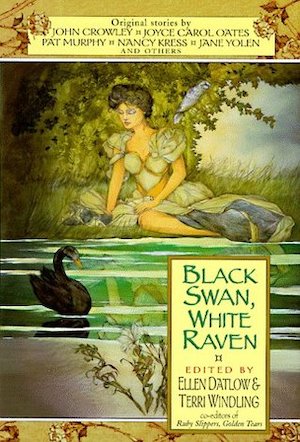
Progressing through three different points of view—Rapunzel’s mother, the witch, and then Rapunzel herself—this is as much a meditation on relationships as it is a fairy tale. It spends the most time of any version that I’ve read pondering the relationship between Rapunzel’s parents, although it soon moves on from them like all the stories do. The witch’s portion of the tale is the shortest, but the most brutal, and Prince Charming is hardly given consideration. In the end, Rapunzel has to grapple with both her mystery parentage and her isolated upbringing. Bishop gives her space to do both, and a garden of her own, and addresses the simplest of ideas: when your entire past has been one cruelty after another, how do you move forward to create a loving and generous life for yourself and your chosen community?
“Rapunzel” by Soman Chainani (Beasts and Beauty: Dangerous Tales)
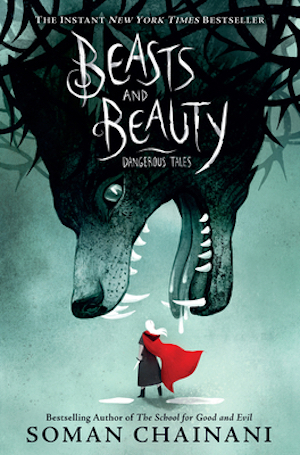
Chainani does a lot of gender-swapping in this collection, with more or less effectiveness in each case. The witch here is actually just an old man who loves his garden, and the gender-swap doesn’t really change the story much. However, Rapunzel is given far more agency here than in traditional tellings, both in terms of attitude and action. And although she’s presented with options for love, the possibilities are all rather smothering, and in the end she reaches for a wilder kind of freedom. We are given enough room, in the narrative, to believe that Rapunzel might be able to mend the relationship with her father-figure and to find romance going forward, but this satisfying retelling first gives her the space to find herself.
“Rapunzel” by Tanith Lee
(Black Heart, Ivory Bones, edited by Ellen Datlow and Terri Windling)
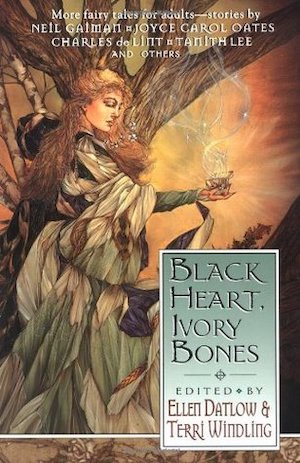
This warm and lovely version of Rapunzel couldn’t be more different from Lee’s other retelling on this list. First cutting the story down to the simplest of encounters—a prince singing a song to entertain himself on the way home from a battle he didn’t want to fight in, a maiden choosing to join in when she recognizes the song—this story is told entirely from the prince’s perspective, and all the fantastical elements are cut away. They meet, sparks fly, they fall for each other over weeks and months while the prince puts off his return home. The king’s longing for the magical, and the prince’s longing for Rapunzel, give them the key to making their marriage acceptable, and then the story comes out, familiar but more sweet because we are able to see both their love and their affection for each other.
“Into the Woods” by Stephen Sondheim and James Lapine
Bonus pick! I don’t feel like I can leave this one out. One of my long-time favorites, this musical blends Rapunzel with a half-dozen other fairy tales. If you’ve only seen the 2014 Disney adaptation of the musical, do yourself a favor and dig up the older Broadway recording with Bernadette Peters as the witch. The original script feels sadder, truer, more complex, and is utterly beautiful. (Not to say there’s anything wrong with Disney’s softened fairy tales, if you’re in the mood for that, but they do tend to lose some of their cathartic lovely strangeness and depth.) Sondheim allowed for some happy endings, some bittersweet partings, and some genuine heartbreak as he wove these classic tales together into something new and unforgettable.
***
Of course, this isn’t meant to be an exhaustive list: What are your favorite versions of the stories we’ve woven around the girl in the tower, named for leafy greens, with the long lovely hair?
Rachel Ayers lives in Alaska, where she writes cabaret shows, daydreams, and looks at mountains a lot. She has a degree in Library and Information Science which comes in handy at odd hours, and she shares speculative poetry and flash fiction (and cat pictures) at patreon.com/richlayers.










